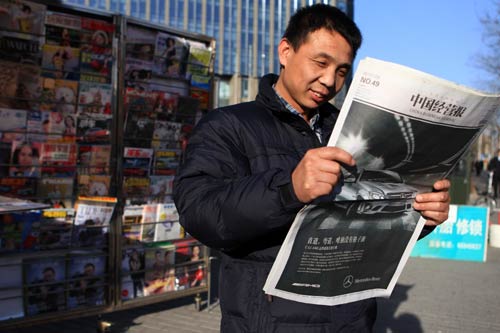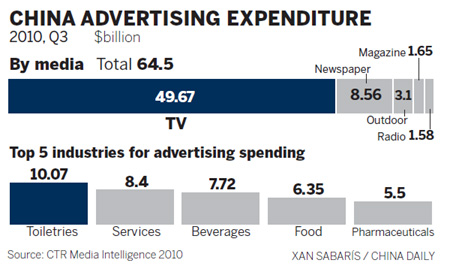Society
Good news for TV, print as advertisers keep faith
By Yu Tianyu (China Daily)
Updated: 2010-12-14 07:37
 |
Large Medium Small |
Upwardly mobile
 |
|
A Beijinger reads a newspaper at a news stand last weekend. Newspapers, television and radio organizations - the traditional media - in China still take a large slice of the advertising cake, although the digital media market is growing. Total advertising expenditure rose 14 percent during the first three quarters of 2010, market research shows. [Feng Yongbin / China Daily] |
Chinese consumers are the most willing to spend their hard-earned cash than anywhere else in the world, according to a recent report by Omnicom Media Group.
According to a company survey, about 45 percent mainlanders say they will spend freely in the next six months, compared to 24 percent in Hong Kong, 18 percent in Singapore and 8 percent in Australia.
The main forces driving consumption in urban areas, say CTR, are "business or high-end" shoppers, as well as the so-called "post-1980s generation".

Businessmen and women generally have more consumption power and influence in their working, social and family circles, "that's why they are so crucial for advertisers", added Sophie Shen, general manager of media and consumption at CTR.
The activities of business leaders mean they cover a wider radius, she said; they read financial newspaper and magazines on flights, they listen to the radio as they drive and they view thousands of advertisements on billboards, on buildings and in restaurants.
Neil Ducray, managing director of Touchmedia, China's largest in-taxi interactive media company, agreed and said that, based on his research, the advertising clients seeing most revenue growth are those targeting the top 20 percent of the population - educated, white-collar workers aged 25 to 44 from households with a monthly income of 5,000 to 10,000 yuan or more.
"As the income (of this group) is going up the most, their expenditures seem to be growing even faster," he said.
Yet, although today's big spenders still turn to traditional media, the next generation of business leaders and officials will likely be more comfortable with the Internet.
"Since most young people spend very few time on traditional media, marketers will have to move to the digital world with their major consumer groups in the future," said Cupples at Omnicom.
Online advertising was worth 9.56 billion yuan in the first half of 2010, up 27.9 percent, according to a report by Nielsen, the global market research firm. The total generated in 2009 was 18 billion yuan.
This year has been an excellent one for Touchmedia, which has seen advertising revenues almost doubling in a number of sectors, including cosmetics, clothing, alcohol, cars and hotels.
So how much of a threat is digital media to the traditional media? Analysts say not much - and suggest that, if integrated well, the two would be better friends than enemies.
"For most (of our clients), the foundations of their media plans are still television or other traditional media, although the shift (toward digital tools) has started," said Ducray.
"Many companies are doubling and even tripling their budgets for digital (and mobile) media marketing for 2011."
The shift overall, however, is likely to be a slow one. After lasting for decades, the traditional media market is not about to be replaced by new media in just a few years, argued Li Kai, vice-president of marketing for VisionChina Media Inc, one of China's largest digital television advertising networks for mass transport systems.
Both new and old have their plus and negative points, making them difficult to compare.
Conventional media offers good market penetration but is weak on awareness, measurability and response. With Internet and mobile marketing, viewers can respond almost instantaneously through their cell phone and computers, but it has a smaller reach.
Newspapers, radio and television also often help drive traffic toward digital media.
"Touchmedia is fortunate to be able to combine the reach of conventional media with the awareness, measurability and response of the Internet or cell phones," said managing director Ducray. "That's been crucial to our success."
Stronger links

The central government in July announced a pilot project to merge telecommunications, Internet and broadcast networks in 12 cities, aiming to make the three sectors compatible and allow users to make telephone calls, surf the Web and watch television through one cable or wireless gateway.
Experts say the move creates more opportunities for both traditional and new media.
In September, VisionChina also signed a memorandum of understanding with CCTV for a strategic partnership that enables the company to introduce its outdoor mobile television-advertising network to the State broadcaster's client base and to conduct joint promotions during its annual advertising slot auction.
The partnership is expected to provide CCTV's clients with more extensive and comprehensive services by combining their advertising platforms, which will allow both to connect traditional and outdoor television, while broadening audiences.
"We believe VisionChina will start benefiting from the cooperation from 2011," said vice-president Li.
"At present, the advertising market for traditional and new media is not about who will eventually drive out who, but it is to create a comprehensive and diversified win-win model."
The State-owned China National Radio launched its China National Broadcasting Network in August in an effort to enter the digital world, following hot on the heels of CCTV's newly established China Network Television.
"We're delighted to witness the changes happening in advertising for old and new media," said Li.
"New media represents a modern trend in marketing and branding and it will definitely gain more recognition and attention in coming years."